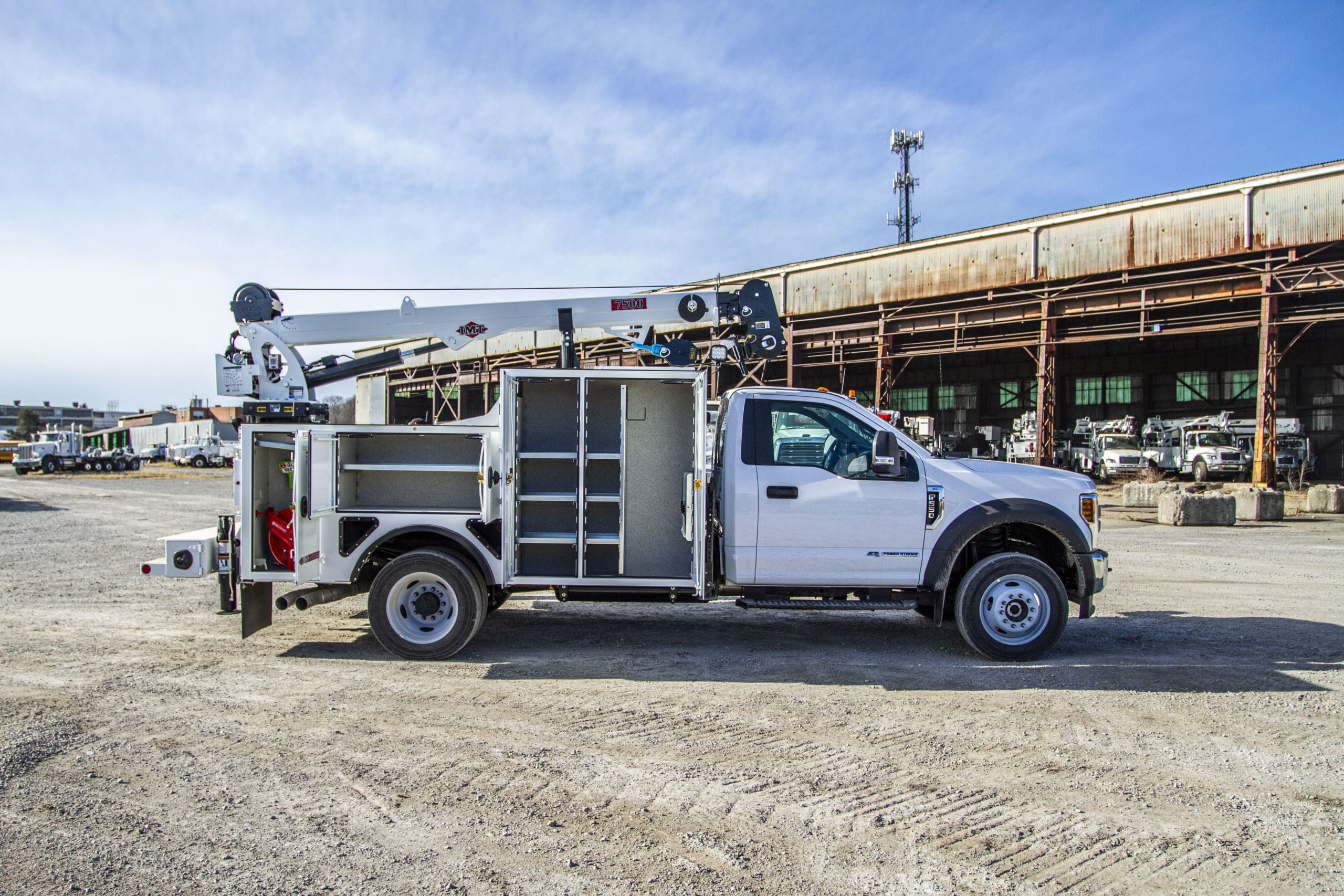
14 Mechanic Service Truck Organization Ideas: Tips to Customize Your Truck
What do you do when a critical piece of machinery breaks down at a job site and work comes to a complete standstill? You have two options. You can arrange for the equipment to be hauled away to a service center, with considerable downtime expense, to have it repaired and returned. Or you can call in a mechanics truck that does the repair work onsite and gets it up and running in considerably less time.
Big operations – such as mining, highway support, rail work, and civic utility – usually own their own fleet of service or mechanics trucks. Independent mechanics often run them too, offering mobile repair to smaller businesses that need the help. Service trucks equipped with cranes are particularly useful for industries like highway support and mobile repair, enhancing the functionality and efficiency of these vehicles for transporting and repairing equipment.
Service bodies have to be kitted out with all the tools and replacement parts needed to repair broken machinery that cannot be easily transported. This means the storage configuration of these vehicles is extremely important.
Below, we have listed 14 key tips to help operators organize their mechanics trucks to make the most of their available space. This can help improve efficiency, increase productivity, and boost their earning potential by being able to service more customers on a daily and weekly basis.
Introduction to Service Truck Organization
A well-organized service truck is essential for increasing productivity and efficiency on the job site. Service trucks, also known as mechanics trucks, play a critical role in providing mobile repair services to various industries, including highway support, civic utility, and rail work. Independent mechanics also rely on service trucks to offer repair work to smaller businesses.
To maximize the potential of a service truck, it’s crucial to have a well-planned storage system that includes custom storage boxes, overhead racks, and a functional storage configuration. This allows for easy access to all the tools and equipment needed to complete repair work, ultimately increasing earning potential and customer satisfaction.
1. Start From Scratch
If your truck has not been organized for some time, the first thing to do is empty the vehicle completely. Lay all the tools down where you can see them.
This will help you identify how they’re going to fit together, shape and size-wise, and which tool needs to be near which for easy retrieval. You will be able to decide if you need extra shelving or any extra outfitting.
You may also see items that don’t need to be placed back in the vehicle, so it’s a great opportunity to de-clutter as well as organize. Removing unnecessary items and trash is essential for maximizing space and effectively organizing your vehicle.
2. Assessing Your Truck
Assessing your service truck is a critical step in organizing your vehicle. Start by evaluating the truck bed and identifying areas where storage space can be optimized. Consider the type of equipment and tools you need to store, and think about how you can utilize vertical space to maximize storage capacity.
Take note of the doors, compartments, and any existing storage systems, and think about how you can use anchor points, bungee ropes, and magnetized strips to secure equipment and tools. Make a list of the items you need to store, including replacement parts, tools, and smaller items, and consider how you can use custom storage boxes, shelving, and dividers to keep them organized.
3. Grade Tools by Usage
The tools you use the most should be close to access points. Lesser used ones can go toward the back.
4. Throw Away Factory Boxes
Keeping tools in the boxes they were packaged in does preserve their sense of newness. But when outfitting a service or mechanics truck, they unnecessarily take up space as their shapes are irregular.
Use custom storage boxes instead, with adjustable shelves and dividers. Additionally, consider using various types of containers, such as fabric parachute bags and door organizers, to keep tools and fasteners separate and easily accessible. They come in many sizes and can be configured to suit your unique needs.
5. Reduce Possibility of Damage
Store heavy, bulky equipment, like a power generator for example, in the lower compartments or closer to the floor to prevent damage to any lighter tools that may be stored in the vicinity. Overhead racks also free up more space to stow and organize smaller items. From there on, load from bottom to top, separating tools so they can be easily found without having to sift and search while a job is in progress.
6. Consider Cab Storage Spaces
Most cabs offer some extra storage space, such as backs of seats, under the seats, and doors. Take advantage of these by using magnetized strips to hang metal tools and cab organizers with divided pockets. Along with electronic devices, paperwork should also be stored in the front. It’s also important to organize small items, or ‘little things,’ using individualized containers to enhance accessibility and organization.
7. Expand Storage With an Underbody Toolbox
Need more space in the truck bed? Integrating different compartment designs ensures tools and equipment are easily accessible. Instead of overloading in an impractical manner, add an underbody toolbox to store the extra stuff.
8. Utilize Vertical Space
Utilizing vertical space is a great way to maximize storage capacity in a service truck. Consider using shelving, overhead racks, and storage bins to store tools and equipment. Vertical space can be used to store items such as ladders, hoses, and other long equipment.
By using vertical space, you can free up floor space and reduce clutter. This can help to improve efficiency and productivity, and make it easier to find the tools and equipment you need. Additionally, utilizing vertical space can help to reduce the risk of damage to equipment and tools, and make it easier to load and unload the truck.
9. Use Anchor Points
Make sure everything stays in place when the truck is moving by anchoring equipment using bungee ropes.
10. Get Enough Lighting
No matter how effectively you organize your truck, it won’t stay that way for long if you don’t have sufficient lighting to see inside. Extra lighting solutions are even more important during winter when natural daylight is in short supply.
11. Safety First
You never know where a service call will take you. For increased safety on the road, your vehicle should have features like back-up cameras, spot mirrors, parking sensors, and partitions.
12. Avoiding Common Mistakes
One of the most common mistakes when organizing a service truck is not considering the specific needs of the job. It’s essential to think about the type of equipment and tools you need to store, and how you can use storage space to maximize efficiency.
Another common mistake is not using anchor points and bungee ropes to secure equipment, which can lead to damage and clutter. Additionally, not utilizing vertical space and not having sufficient lighting can also lead to inefficiencies and accidents.
By avoiding these common mistakes, you can create a well-organized and efficient service truck that improves productivity and reduces downtime.
13. Look Professional
The look of a well-organized truck instills confidence in customers. So not only will you be making the job easier for yourself, your truck operation may build a reputation for efficiency just by how professional the inside of it is kitted out. Removing unnecessary items, including supplies, is essential for maximizing storage space and achieving sustainable organization.
14. Maintenance and Upkeep
Regular maintenance and upkeep are essential to keep a service truck organized and efficient. This includes regularly cleaning and inspecting the truck, checking for damage and wear, and performing routine maintenance tasks. It’s also essential to regularly review and update the storage system to ensure it remains efficient and effective. By performing regular maintenance and upkeep, you can help to prevent clutter and damage, and ensure that the truck remains a safe and productive work environment. Additionally, regular maintenance can help to extend the life of the truck and its equipment, and reduce the risk of accidents and downtime.
Shop Service Trucks Here
Looking for new or used service trucks or mechanics trucks? Considering rental? Contact us today!
FAQs – Organizing a Service Truck
1. What’s the first step to effectively organizing my service truck?
Start by completely emptying the truck and laying out all tools visibly. This lets you assess size, shape, and frequency of use—crucial for determining what stays, where it should go, and whether you need extra shelving or outfitting.
2. How do I optimize storage space in my service truck?
Evaluate all compartments, doors, and vertical spaces. Think creatively: install shelving, overhead racks, magnetized strips, or use bungee ropes and anchor points to keep gear secure and easily accessible.
3. What are some common organizational mistakes to avoid?
-
Not tailoring the setup to the job’s specific tool and equipment requirements.
-
Overlooking vertical storage or ignoring secure fastening methods.
-
Failing to provide adequate lighting inside the truck—these oversights can lead to clutter, inefficiency, or even damage.
4. Why does maintenance matter in truck organization?
A clean-out and inspection schedule prevents accumulation of unused items and keeps storage systems effective. Periodic review of layout and upkeep of the truck and its components ensures ongoing productivity and safety.
5. How does a well-organized truck impact my business image?
A professional, tidy truck sends a strong signal of competence and reliability. Beyond improving workflow, it builds customer confidence in your work and brand.




